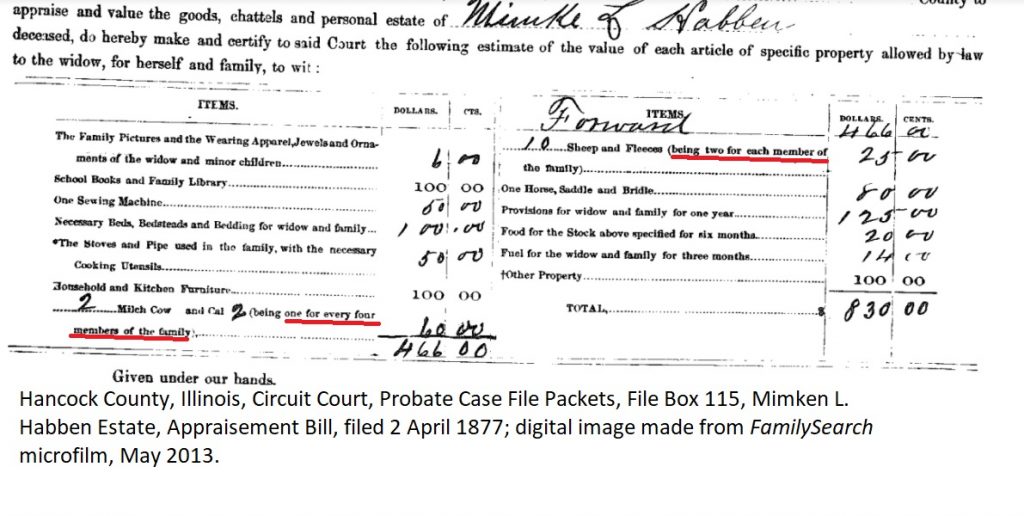
It always pays to read the details. Genealogical discoveries, large and small, are often obtained from thinking about the implications of everything written in a document.
That’s true with the appraisement of the estate of Mimka L. Habben in Hancock County, Illinois, in the spring of 1877. Illinois state statute dictated what was to be a part of the “widow’s award” before the bills of the estate were paid. The award could be actual items in the household and barns or the cash equivalent if the family so chose or did not have the specific items. The “widow’s award” was so that not all of the family’s personal effects would be sold to pay bills and leave them without. Books, a sewing machine, family beds, the stove, household and kitchen furniture, some livestock, provisions for a specific period of time, and other items were included.
State statute–and the appraisement form–indicated that widow’s award was to include two sheep per member of the household. Antje, widow of Mimka L. Habben was awarded ten sheep. This suggests that there were five people in her household at the time of the appraisement. The family was awarded two cows–one for every four members of the family. That number is consistent with five members of the household.
After all, you can’t have a fractional cow. Five household members would have warranted 1.25 cows. To give the family their 1.25 cows meant they’d get two cows.
In this appraisement I learned that the Habben household in the Spring of 1877 consisted of five people. That told me that four of Antje’s children were living with her. The probate papers indicate that Mimka’s heirs at the time of his death were:
- Jann Mimka Habben–a son
- Johann Mimka Habben–a son
- George Mimka Habben –a son
- Antje Habben–a daughter
- Meta Fecht–a married daughter
- Meta Huls–a granddaughter
Meta Hul’s mother predeceased Mimka Habben. Meta would have been seven years old at the time of this estate appraisement. In 1880, she is known to have been living with her grandmother, Antje and her mother’s siblings who were still living at home.
Was Meta living with her grandmother in 1877? Was she living elsewhere? Was she not considered a member of the household for the purposes of the estate appraisement? I will need to review state statute to see if it mentions specifically who qualifies as a household member.
The items Mimka L. Habben owned at his death, beyond the items in the widow’s award, would be inventoried and appraised. If there was not money to pay the bills of his estate, the appraised items could have been sold to pay those bills.
But what of Meta? I don’t know and didn’t think about it until I got to looking at these sheep.
And here I thought I had all the answers when I saw they got ten sheep.


6 Responses
I am curious to learn when this law about a “widow’s award” was first enacted?
These were acts generally in the mid-to-late 19th century and were determined by state statute. One would need to refer to contemporary state statute to see specifically what the award was and when it was enacted.
My guess is that the granddaughter was still with her grandmother and the married daughter was elsewhere.
The married daughter is elsewhere. Five household members would be the widow and the four single children–probably. It could be that one of the older sons was working as a hired man elsewhere.
My guess is that Meta’s mother was still living in 1877, and Meta was living with her or with her father or other grandmother or somebody else. A lot could have happened in the little girl’s life in the years between 1877 and 1880.
Meta’s mother was deceased by 11 February 1877 when the grandfather died. But you are right, a lot can happen in a very few years.